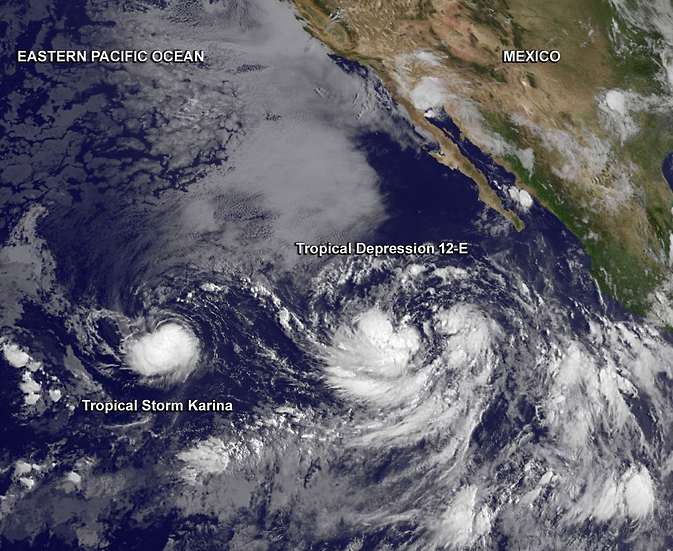Twelfth Tropical Depression Appears Huge on Satellite Imagery

On August 18, NOAA's GOES-West satellite captured an image of tiny Tropical Storm Karina followed to the east by the massive Tropical Depression12-E. Image Credit: NASA/NOAA GOES Project
Tropical cyclones are usually a couple of hundred miles in diameter. The average size of a tropical cyclone is around 304 nautical miles (350 miles/600 km) in diameter.
The National Hurricane Center noted on August 18 at 11 a.m. EDT that Tropical Depression 12-E was at least 800 nautical miles (920.6 miles/1,482 km) in diameter! By comparison, Tropical Storm Karina is a couple of hundred miles in diameter.
At 11 a.m. EDT on August 18, tropical-storm-force winds extended outward up to 80 miles (130 km) from Karina's center.
NASA/NOAA's GOES Project at the NASA Goddard Space Flight Center in Greenbelt, Maryland generates visible and infrared satellite imagery of the Eastern and Central Pacific Oceans from NOAA's GOES-West and GOES-East satellites.
On August 18, at 11 a.m. EDT (1500 UTC) the center of Tropical Depression Twelve-e was located near latitude 16.7 north and longitude 117.7 west, that's about 665 miles (1,065 km) southwest of the southern tip of Baja California.
Maximum sustained winds are near 35 mph (55 kph), and the depression is expected to become a tropical storm late on August 18.
The depression is moving toward the west-northwest near 8 mph (13 kph) and the National Hurricane Center expects a turn toward the northwest followed by a turn north on August 19.
Text credit: Rob Gutro
NASA's Goddard Space Flight Center
Media Contact
More Information:
http://www.nasa.gov/content/goddard/12e-eastern-pacific-ocean/All latest news from the category: Earth Sciences
Earth Sciences (also referred to as Geosciences), which deals with basic issues surrounding our planet, plays a vital role in the area of energy and raw materials supply.
Earth Sciences comprises subjects such as geology, geography, geological informatics, paleontology, mineralogy, petrography, crystallography, geophysics, geodesy, glaciology, cartography, photogrammetry, meteorology and seismology, early-warning systems, earthquake research and polar research.
Newest articles

Making diamonds at ambient pressure
Scientists develop novel liquid metal alloy system to synthesize diamond under moderate conditions. Did you know that 99% of synthetic diamonds are currently produced using high-pressure and high-temperature (HPHT) methods?[2]…

Eruption of mega-magnetic star lights up nearby galaxy
Thanks to ESA satellites, an international team including UNIGE researchers has detected a giant eruption coming from a magnetar, an extremely magnetic neutron star. While ESA’s satellite INTEGRAL was observing…

Solving the riddle of the sphingolipids in coronary artery disease
Weill Cornell Medicine investigators have uncovered a way to unleash in blood vessels the protective effects of a type of fat-related molecule known as a sphingolipid, suggesting a promising new…





















